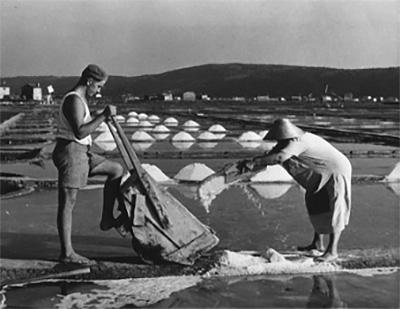
In the most northerly saltpans of the Mediterranean, Piranska sol PDO has been produced using the same techniques for 700 years.
Celebrated for its purity, whiteness and absence of clay residue, Piranska sol PDO is lighter and more delicate than other salts, and has played an important role in economic activity along the Slovenian coast throughout history.
Origins
The first written record of the Piran saltpans dates back to 804, when several small saltpans in the area were owned by monastic orders. Piran’s town charter from 1274 contains a number of regulations relating to the saltpans and highlights the town’s right to produce and trade in salt.
The use of the ‘petola’ – the natural base of algae and minerals which gives Piranska sol its colour and quality – began in 1358, when the Piran Statute stated that reconstruction work was needed on the saltpans because the presence of clay was causing an unsightly brown colouring to appear in the salt.
With the help of salt workers from the island of Pag, Piran began to use the petola in production. This resulted in a much purer, whiter coloured salt, and was the birth of a practice that continues to this day.
After 300 years of prosperity, regional instability in the early 18th century was the catalyst for a period of decline for the Piran saltpans. This ended when the Austro-Hungarian administration took them over; production restrictions were ended, the sale price of salt was increased and mandatory purchase of all the salt produced was ordered, restoring the saltpans to their former glory.
Following the collapse of the Austro-Hungarian monarchy, the 20th century continued to be a colourful period in the history of the saltpans, which came under both Italian and Yugoslav administration before Slovenia became an independent state in 1991.
The specific characteristics and age old production methods of Piranska sol saw it recognised as a protected designation of origin (PDO) in 2014.
Production
Every step in the production of Piranska sol PDO takes place in the Sečovlje Salina nature park and Strunjan Nature Reserve, which are located in the municipalities of Piran and Izola on the Slovenian coast.
The key feature of Piranska sol PDO is that it is produced almost entirely by hand, using the same methods that have been used for 700 years. The aforementioned ‘petola’ base is central to this process. It is a 1cm-thick crust, cultivated and maintained using traditional wooden tools, and is comprised of cyanobacteria, gypsum, carbonates and some clay.
It provides two functions: first, it prevents the salt from mixing with the sea mud below, allowing it to retain its pure, white aesthetic; secondly, it acts as a biological filter which prevents heavy metal traces from settling in the salt crystals.
The crystals are manually raked into conical piles every day using a traditional wooden rake called a gavero. Raking the crystals daily prevents them from forming the thick, hard layer which is commonly found in mechanically collected sea salt.
As a result, the crystals form in a way that retains some of the original seawater, making them lighter and more delicate, and allowing them to dissolve more quickly. Notably, Piranksa sol PDO is not refined or rinsed during the production process, giving it a naturally balanced mineral composition, free from additives.
The basic technology for producing salt – using basins for gradual evaporation – has persisted throughout history. The main differences between individual saltpans in the Mediterranean are in the method used for collecting or harvesting the salt in these basins, where the process is dictated by the microclimate of the region.
Where there is a favourable climate, a continual crystallisation process can be used. Where conditions are volatile – as they are in Piran – the risk of summer thunderstorms and heavy rainfall means the salt must be harvested every day. The practice of collecting the salt each day, along with the use of the petola base, are what makes Piranska sol PDO distinct from other types of salt in Europe and beyond.
The production of Piranska sol PDO has taken place in harmony with its surroundings throughout history, and has added both natural and cultural value to the environment of the region.
More information
Piranska sol PDO – legal and technical information




